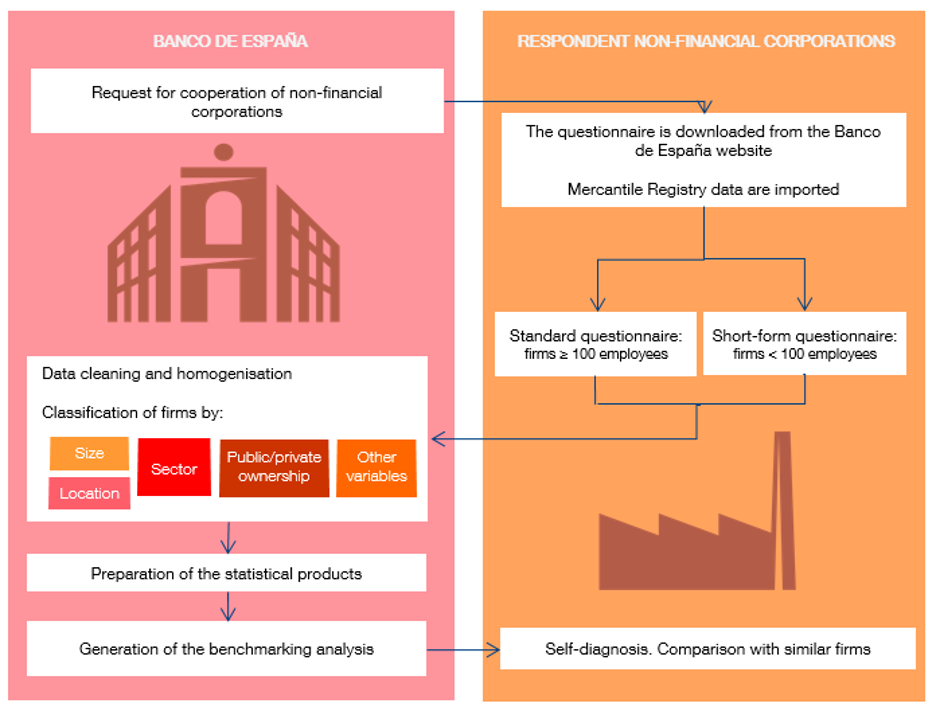40 years of quality statistics on Spanish firms
The Banco de España’s Central Balance Sheet Data Office was launched in 1983 to create and maintain highly detailed databases on Spanish firms. It has since become a benchmark for statistical information and research on the Spanish business sector thanks to the wealth and quality of its data.
27/11/2023
Any rigorous economic analysis requires high-quality statistical data that have been systematically collected and organised. Compiling statistics on non-financial corporations has been the main task of the Banco de España’s Central Balance Sheet Data Office (CBSO) since its launch.
The CBSO provides deep insight into the economic and financial position of Spanish firms
The work carried out over these past 40 years and our drive to adapt and improve have provided deep insight into the economic and financial position of Spanish firms (see Figure 1). This insight is not only key in and of itself; it is also crucial to preparing the Spanish national accounts and to designing and evaluating economic policy in Spain.
Figure 1
CENTRAL BALANCE SHEET DATA OFFICE (CBSO) MILESTONES

SOURCE: Banco de España.
NOTES: XBRL=eXtensible Business Reporting Language, a language used by firms for exchanging information online. CBV=Listed group database. CBR=Unlisted group database. CBH=Holding company database.
What information is compiled and how?
CBSO information is looked at through two lenses:
- First, from a macroeconomic perspective, we compile data on firms’ contribution to the economy as a whole. This information helps to prepare the Financial Accounts of the Spanish economy.
- Second, from a more business-centric angle, we analyse multiple parameters that measure firms’ economic and financial health, such as their productivity, profit ratios and debt levels.
All this statistical information is obtained through different channels. Figure 2 describes the process.
Figure 2
COOPERATION OF FIRMS WITH THE CBSO. SUMMARY OF THE PROCESS

SOURCE: Banco de España.
One source is the data firms report voluntarily to the Banco de España in a questionnaire.
Currently around 10,000 firms contribute to the CBSO annually and some 1,000 do so quarterly. In return, they each receive a benchmarking analysis of their individual economic and financial situation compared with other firms in their sector.
Mercantile registries are a second data source. We have worked with them since 1991 to facilitate the use, for statistical and research purposes, of the annual accounts firms are required to file with the mercantile registry where their head office is located.
Through this channel we obtain data on around 800,000 firms (accounting for approximately 70% of Spanish non-financial corporations’ employment). This is a very high level of coverage.
Over the years, the information available in the CBSO has grown in quantity, scope and quality, as we constantly bid to improve and adapt
But it is not just about quantity. The quality of the information is also very high, thanks to the strict controls and advanced data management processes implemented by a committed team of experts.
Over the years the information available in the CBSO has grown in scope and quality, as we constantly bid to improve and adapt to economic and technological shifts.
For instance, in recent years we have made headway in the processing of data on corporate groups, SMEs and FinTech. More recently, we have also turned our attention to sustainable development in the corporate sphere and started using data science techniques and artificial intelligence.
How can this information be accessed?
CBSO data are stored in two large databases, depending on whether they were collected through the Central Balance Sheet Data Office Annual or Quarterly Surveys (CBA and CBQ, respectively).
The information in these databases is made available to the general public, the firms participating in the surveys and researchers through various statistical publications and applications![]() (see Figure 3). These materials are available for free on the Banco de España’s website.
(see Figure 3). These materials are available for free on the Banco de España’s website.
Figure 3
DISSEMINATION OF INFORMATION. PUBLICATIONS AND APPLICATIONS

SOURCE: Banco de España.
NOTE: BACH = Bank for the Accounts of Companies Harmonised.
Since 2019, researchers can also download the CBSO’s most granular data through BELab, the Banco de España’s data laboratory.
All of this has helped the Banco de España provide a useful service to firms and society as a whole and has made it a key player in the field of statistics.
DISCLAIMER: The views expressed in this blog post are those of the author(s) and do not necessarily coincide with those of the Banco de España or the Eurosystem.



